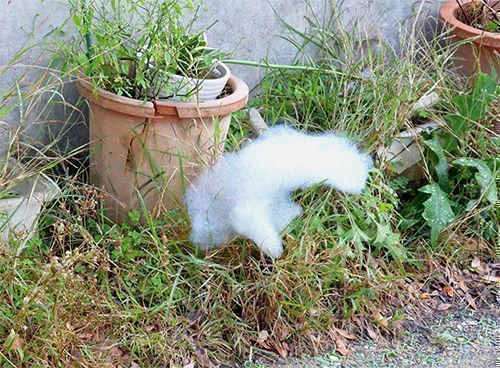JASDF finds 128 times national guideline levels of chemicals like PFOS in water on Naha Base

April 7, 2021 Ryukyu Shimpo
On April 7, study results were issued on the Japan Air Self-Defense Force (JASDF) Naha Base website concerning a recent incident in which a foam fire-extinguishing agent leaked off of said base. PFOS and PFOA, which are types of organic flourine compounds, were detected in contaminated water collected from on-base aqueducts into which the fire-extinguishing agent flowed. As such, words of apology were offered in the name of the base’s commander. The incident occurred on February 26, and although a base spokesperson initially said that “PFOS are not contained” in the agent, PFOS were detected in some foam gathered near the site of the incident by a Ryukyu Shimpo reporter.
The water was found to contain 3,010 nanograms of PFOS per liter and 3,380 nanograms per liter of PFOA, totalling 6,390 nanograms of these compounds per liter of water. The national provisional guideline value is 50 nanograms total of PFOS and PFOA per liter of water, and the detected value is 128 times this guideline value.
Naha Base’s commander explained that at the time concerns came to light he had announced PFOS were not contained in the foam fire-extinguishing agent that had leaked off-base, but the study results have established that PFOS are contained therein, and he apologizes and amends his former statement.
Another organic fluorine compound, PFHxS, has also been detected in the water at 3,040 nanograms per liter.
On April 7, the Naha City government also announced study results showed that a total of 360 nanograms of PFOS and PFOA per liter of water was detected.
Immediately after Naha Base exchanged the fire-extinguishing agent containing PFOS for a fire-extinguishing agent that does not use PFOS, analysis showed that PFOS components remain within pipes. When the agents were exchanged, the pipes were not cleaned out. A base spokesperson explained that “since the results of analysis by the Naha City government upstream and downstream of the base show a trend differing from the study results, we will conduct analysis again.”
The JASDF initially publicized that the fire-extinguishing agent does not contain PFOS, and poses little or no toxicity or harm. However, when the foam gathered near the site of the incident by the Ryukyu Shimpo reporter was analyzed by Associate Professor Kouji Harada of Kyoto University (specializing in environmental hygiene), results showed that PFOS was detected in the foam.
On the morning of April 7, this newspaper had placed an inquiry to Naha Base as to when the study results would be announced, and the response was that the study was ongoing.
(English translation by T&CT and Erin Jones)
Previous Article:Reading of names at school entrance ceremonies in Naha halted by flight of U.S. planes
Next Article:Himeyuri Peace Museum reopens after renovation, “to show that our grandparents’ generation was not just one that experienced war”
[Similar Articles]
- Organic fluorine compound contamination detected at six times index value in Uchidomari River
- High levels of PFOS detected in Kin Town, the highest level at site adjacent to US base
- Kyoto University professors detect PFOS concentration of 4 times national average in Ginowan residents’ blood
- OPG finds high PFOS concentrations near Kadena Air Base, advises against drinking the water
- Futenma Begins Disposing of PFAS-Polluted Water in Sewage System Disposal is “Safe and Clean”, Says U.S. Military
 Webcam(Kokusai Street)
Webcam(Kokusai Street)


